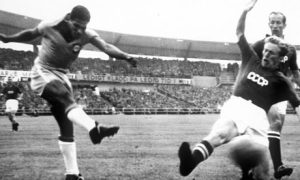Brazilian Football And The 1958 World Cup – “It’s all over. Brazil has won its first World Cup. The 30cm statue of a woman created in 1930 is now the most coveted trophy in the world’s greatest international sport.” “Brazil itself is the talk of the town,” John Mulliken wrote in a 1958 Sports Illustrated article.
Brazilian Football And The 1958 World Cup
oragoo – The 1958 World Cup final (Brazil 5 vs Sweden 2) was played on June 29 of the same year. Courtesy of Arquivo do Estado de São Paulo. When General Charles de Gaulle said in 1963, “Brazil, ce n’est pas un pays sérieux” (Brazil, this is not a country to be taken seriously), he was referring to the younger generation of Brazil as a country of perception. But like many observers, the French leader missed an important point about Brazil. You see, in 1963, Brazil was serious about football.
From 1938, when Brazil first entered the world of international football, until the 1970s, Brazil experienced a golden age for the sport. The national team’s success peaked at the 1970 FIFA World Cup in Mexico, making Brazil the only country to win the cup three times. From the 1930s to the 1970s, Brazilian football strengthened Brazil’s national identity. The unique prominence of Brazilian football provides a contrasting perspective to the common view that Brazil is a backward and underdeveloped country. However, Brazil’s positive image based on its football abilities still faces contradictions that affect the country’s reputation and, ultimately, its development. External reporting and analysis never ceases to depict Brazilian football as yet another example of stagnating national development, a commodity that has not yet been fully developed.
The rise of Brazilian football
When football first came to Brazil in 1894, England was an elite sport. The sport is largely confined to private amateur clubs in urban areas, and most of the players are European. However, over time, as this sport spread to suburban areas inhabited by lower class people, pelada (informal) culture emerged. Poor black Brazilian youth played spontaneous matches on beaches and fields. A major breakthrough came in 1923 when the Vasco de Gama Club of Rio de Janeiro, founded in 1898 by wealthy Portuguese bankers, allowed poor blacks and mulattos to join, and that year they became champions of Rio de Janeiro.
Baca Juga : A Small Corner Of Brazil Would Be Okinawa
The quadrennial World Cup is a kind of “mock war” that allows Brazil to assert its dominance. With its unique emphasis on footwork, dribbling, natural rhythmic movements, and improvisation, the “beautiful game,” as the British called it, became a national asset. Brazil hosted the 1950 World Cup at Rio’s new stadium, the Maracana, the largest stadium in the world at the time. Football as an export product
Although soccer helped elevate Brazil in many ways in the second half of the 20th century, soccer coverage in the United States and other countries tends to reflect historical patterns in coverage of Brazilian culture, economics, and politics. Football is considered one of the country’s natural resources. The power of football, like any other resource, has the potential to help strengthen the country, but if exploited, it would leave Brazil at the mercy of foreign powers. Brazilian wood, coffee and sugar from other periods in Brazilian history. When soccer finally developed in Brazil, foreign companies from more modern European countries and the United States developed Brazilian soccer and its natural resources. And just like these resources, external forces have gradually eroded and polluted the inherent power of Brazilian football.
Baca Juga :Hal Yang Dapat Dilakukan di Tokyo Selama Musim Salju
nostalgic game
Not only was Brazilian football portrayed as a natural resource by the foreign press, but after the 1958 World Cup, more and more foreigners sought concrete steps to commercialize and exploit this natural resource. “Brazil is the world’s largest exporter of sugar, coffee and football players,” wrote Alex Veloz in his 2002 analysis of football history, Futebol: The Brazilian Way of Life. “I consider this country as a big plantation where Futebol is an agricultural product. This country is a sports monoculture, and football reflects the old class society.”
In the quest to extract valuable resources from Brazilian football, it was the players who were the first to fall by the wayside. American and European teams began to plunder Brazil’s domestic talent and turn players into exports. When a rising star becomes a championship favorite, he is traded to Europe or America and joins a team there. Perhaps the most notable example: Pele signed a $4.7 million contract to play for the New York Cosmos in 1975, shortly after leading his national team to victory in the 1970 World Cup.

